Plant growth parameters and soil potassium pool as influenced by potassium fertilization in Kharif season rice
Bạn đang xem bản rút gọn của tài liệu. Xem và tải ngay bản đầy đủ của tài liệu tại đây (257.52 KB, 7 trang )
Int.J.Curr.Microbiol.App.Sci (2019) 8(3): 1547-1553
International Journal of Current Microbiology and Applied Sciences
ISSN: 2319-7706 Volume 8 Number 03 (2019)
Journal homepage:
Original Research Article
/>
Plant Growth Parameters and Soil Potassium Pool as Influenced by
Potassium Fertilization in Kharif Season Rice
Sai Parasar Das*, Goutam Kumar Ghosh, Suchhanda Mondal,
Pabitra Kumar Biswas and Manik Chandra Kundu
Department of Soil Science and Agricultural Chemistry, Institute of Agriculture,
Visva-Bharati, Sriniketan, West Bengal (731 236), India
*Corresponding author:
ABSTRACT
Keywords
Soil potassium pool,
Plant parameters,
Potassium
fertilization
Article Info
Accepted:
12 February 2019
Available Online:
10 March 2019
The field experiment was conducted during kharif season of 2016-17 and 2017-18 to find
the influence of potassium fertilization on different growth and yield parameters of rice
along with soil potassium pool. The experiment was laid out in Randomized Block Design
with treatments comprised of different doses of potassium viz. 15, 30, 45, 60, 90, 120
kg/ha and a control plot without any fertilizer and it was replicated thrice. The experiment
revealed that the plant growth parameters viz. plant height, number of active tillers per
plant, test weight and yield were significantly increased with application of potassium
fertilizer. With application of potassium fertilizer, plant parameters such as plant height, no
of active tillers, test weight and yield of rice increased significantly. Pooled data of both
the years suggested that, water soluble, exchangeable, available and HNO3 soluble
potassium increased at all three stages, as fertilizer dose increased. The exchangeable
potassium in control plot showed a decreasing trend with time.
Introduction
Attaining Food Security had been a major
challenge for the nation since independence.
With ever increasing population it is very
crucial for our country to increase food grain
production from the current level. United
Nations Sustainable Development Goal no. 2
also talks about increasing agro productivity
two fold by the end of 2030. The current
stagnation in food grain production
necessitates special initiatives to meet the
increasing demands of food grains. Expansion
of the area has ceased to be a major source of
increased output. Most of the targeted increase
in production now must result from greater
yield per hectare. Appropriate nutrient
management in general and potassium
management in particular, will play a major
role in overcoming stagnation in crop
production. The picture of crop responses to
potassium (K) in India has been changing with
time. Although Indian soils were sufficient in
terms of potassium status but intensive
cropping without its application has rendered
the soils deficient in potassium. There is a
1547
Int.J.Curr.Microbiol.App.Sci (2019) 8(3): 1547-1553
growing evidence of increasing deficiency of
K as a result of inadequate use of the nutrient
as compared to nitrogen (N) and phosphorus
(P). International potash institute found K
balance negative in many soils even under the
optimum rates of fertilization.
In view of the above considerations, the
experiment was conducted to characterize the
soil with respect to potassium status and
determine different forms of potassium in soil
and its dynamics.
Materials and Methods
The field experiment was conducted in the
kharif season of 2016-17 and repeated the
same in the year 2017-18 at the Agricultural
Farm of PalliSiksha Bhavana (Institute of
Agriculture), Visva- Bharati, Sriniketan which
situated at 23°39΄ N latitude and 87°42΄ E
longitude with an average altitude of 58.9 m
above the mean sea level under sub humid
semi-arid region of West Bengal.
The experiment was conducted in a
randomized block design having three
replications in both the years. Seven different
treatments were randomly allotted to the plots
following random number table (Gomez and
Gomez, 1976)
The experiment was laid out in Randomized
Block Design with three replications in 6m x
5m plots and spacing of 20cm. × 10cm.The
treatment comprised of different doses of
potassium viz. 15,30, 45, 60, 90, 120 kg/ha
along with a control plot without having any
fertilizer applied.
Height of plants and number of tillers per
plant was measured by taking measurement of
5 plants from each plot was at 45, 70 and 90
DAT. A sample of 1000 seeds was drawn
randomly from each plot. The sample was
weighed and analyzed statistically. After
harvesting was done from individual plot, the
grain was weighed with balance and yield per
hectare was calculated.
Water soluble potassium was determined by
following procedure of Black et al., (1965) by
taking soil and water in 1:2 ratio, shaking on
the mechanical shaker for two hours and
allowing it to reach equilibrium for additional
sixteen hours. Available potassium of soil
samples was determined in soil: neutral
normal ammonium acetate extract (1:5) of the
soil using flame photometer (Jackson 1973).
Exchangeable K was the difference between
available and water soluble potassium. Nitric
acid soluble potassium was determined by
following procedure of Wood and Deturk
(1941).
Results and Discussion
Plant parameters in rice
Plant height
The observations on plant height each year,
recorded at 45, 70, and 90 days after
transplanting
(DAT)
were
analyzed
statistically and presented in the table no
1.The plant height of kharif rice was highly
influenced by the application of potassic
fertilizer in every stage i.e. 45, 70, and 90days
after transplanting (DAT).
At 45 DAT the height increased from control
(T1) to T5 having potassium application rate
60 kg/ha then declined. At 70 DAT and 90
DAT height increased with increase in
fertilizer dose. Highest value was recorded in
T7 treatment which was significantly higher
than other treatments except T4, T5, T6, with
which it was at par. Similar effect of
potassium fertilization was reported by
Bahmaniar et al., (2007), Biswas et al., (2001)
and Mukherjee and Sen (2005).
1548
Int.J.Curr.Microbiol.App.Sci (2019) 8(3): 1547-1553
No. of active tillers/hill
A perusal of pooled data shows that no. of
active tillers per hill was highly influenced by
potassium fertilization. Highest no. of active
tillers were recorded in treatment T7 followed
by T5 and T6 and was significantly higher than
rest of the treatments (table no 2). Similar
results were corroborated by Thakur et al.,
(1993), Meena et al., (2003) and Tabar et al.,
(2012).
Test weight
The test weight data from different years were
pooled together where it can be noticed that
test weight increased with increasing the dose
of potassium fertilizer. Highest test weight
was recorded in treatment T7 which was at par
with the all treatments except control with
which it was significantly higher. The pooled
data revealed that the range of test weight was
from 11.94 to 15.47 g.(table no 2).
Grain yield
Grain yield was also influenced by
fertilization as revealed from table no 2. It
ranged from 2.04 to 3.24 t ha-1 and 1.94 to
3.40 t ha-1for years 2016-17 and 2017-18
respectively. The pooled data revealed that
highest yield was recorded from treatment T5
which was significantly higher than treatment
T1 and T2. The second highest yield was
recorded in treatment T6 and T7 followed by
treatment T4. Krishnappa et al., (2006)
revealed that potassium application had
positive impact on yield of rice. Similar
observations were reported by Mathad et al.,
(2002) and Biswas et al., (2001).
Soil potassium pool
Water soluble potassium
Soil samples from surface soils were analyzed
for water soluble potassium at different
intervals of kharif season rice for successive
years 2016-17 and 2017-18 and pooled
together in table no 3. At 45 DAT highest
water soluble potassium was present in
treatment of highest dose of fertilizer
application, T7 and was significantly higher
than all other treatments. Similar trends were
seen during various stages of crop 70 DAT
and 90 DAT. The range of water soluble
potassium was in the range of 10.04 to 23.20
ppm, 9.64 to 22.97 ppm and 8.86 to 22.36
ppm for 45 DAT, 70 DAT and 90 DAT
respectively. The control plot showed a
different trend than other treatments where
water soluble potassium decreased with
passing of time, while for the rest of the
treatment this trend was absent due to
fertilization. Similar results were revealed
from experiments by Padole and Mahajan
(2003), Ranganathan and Sathyanarayana
(1980) and Pharande and Sonar (1996). The
quantity of water soluble K was found lower
than other potassium fractions which could be
due to the fact that K in solution is present in
lower quantities in comparison to other
potassium reserves (Bansal et al., 2002).
Exchangeable potassium
Highest exchangeable potassium was found in
T7 treatment at all three stages 45, 70, 90 DAT
i.e. 79.95, 80.96, 76.71 ppm respectively and
the values were significantly higher than all
other treatments except treatment T5 and T6
with which it was at par. Lowest value was
recorded in control plot having no potassium
application (table no 4). Pooled data suggests
that, at all three stages exchangeable
potassium increased as fertilizer dose
increased. The exchangeable potassium in
control plot showed decreasing trend with
time which was due to the depletion of
potassium pool with plant uptake and
leaching. Similar trend was observed from the
pooled data of all the treatments except
treatment T7 where no such trend was
discernible.
1549
Int.J.Curr.Microbiol.App.Sci (2019) 8(3): 1547-1553
Table.1 Effect of potassium fertilizer application on plant height (in cm) in Kharif Rice
Treatments
T1 (N60P30K0 )
T2 (N60P30K15)
T3 (N60P30K30)
T4 (N60P30K45)
T5 (N60P30K60)
T6 (N60P30K90)
T7 (N60P30K120)
S Em (+)
45 DAT
2016-17 2017-18
36.82
35.67
40.73
39.28
41.21
40.21
42.31
41.75
45.59
44.19
45.72
43.75
43.23
42.05
1.20
1.34
CD at 5%
3.71
4.12
Pooled
36.25
40.00
40.71
42.03
44.89
44.73
42.64
0.90
70 DAT
2016-17 2017-18
72.32
71.56
76.27
74.73
80.94
79.86
79.46
77.42
79.01
82.07
83.37
79.65
85.55
79.30
2.10
2.23
2.63
6.48
6.88
Pooled
71.94
75.50
80.40
78.44
80.54
81.51
82.42
1.55
90 DAT
2016-17 2017-18
99.76
101.27
108.81
108.21
109.53
111.27
111.79
111.00
112.85
113.71
113.60
113.10
112.52
117.19
2.92
3.03
Pooled
100.52
108.51
110.40
111.40
113.28
113.35
114.85
2.17
4.52
9.01
6.32
9.33
Table.2 Effect of potassium fertilizer application on number of active tillers/hill, test weight and
grain yield in kharif rice
Treatments
No. of Active Tillers/hill
2016-17 2017-18 Pooled
Test weight (in g)
2016-17 2017-18 Pooled
Grain Yield (in t/ha)
2016-17 2017-18 Pooled
T1 (N60P30K0 )
T2 (N60P30K15)
T3 (N60P30K30)
T4 (N60P30K45)
T5 (N60P30K60)
T6 (N60P30K90)
T7 (N60P30K120)
S Em (+)
CD at 5%
8.74
10.93
12.20
12.85
15.05
14.62
15.54
0.44
1.36
13.69
15.23
15.21
15.12
15.56
15.64
15.75
0.37
1.15
2.04
2.59
2.98
3.18
3.24
3.18
3.21
0.16
0.48
9.97
11.70
13.80
13.47
15.47
15.14
15.81
0.47
1.44
9.35
11.32
13.00
13.16
15.26
14.88
15.68
0.33
0.95
10.18
14.09
14.46
14.22
14.97
14.96
15.20
0.61
1.88
11.94
14.66
14.84
14.67
15.27
15.30
15.47
0.36
1.05
1.94
2.31
3.01
3.33
3.39
3.40
3.37
0.16
0.48
1.99
2.45
2.99
3.26
3.32
3.29
3.29
0.11
0.33
Table.3 Effect of potassium fertilizer application on water soluble potassium (in ppm) in soils of
kharif rice
Treatments
T1 (N60P30K0 )
T2 (N60P30K15)
T3 (N60P30K30)
T4 (N60P30K45)
T5 (N60P30K60)
T6 (N60P30K90)
T7 (N60P30K120)
S Em (+)
CD at 5%
45 DAT
2016-17 2017-18
10.23
9.85
11.60
11.16
15.90
15.22
14.94
14.48
17.98
17.78
20.12
19.80
23.33
23.07
0.53
0.84
1.64
2.58
Pooled
10.04
11.38
15.56
14.71
17.88
19.96
23.20
0.51
1.49
70 DAT
2016-17 2017-18
9.70
9.57
12.55
11.52
15.91
14.95
14.61
13.65
17.69
16.83
20.01
18.96
23.25
22.68
1.08
0.92
3.34
2.84
1550
Pooled
9.64
12.04
15.43
14.13
17.26
19.48
22.97
0.71
2.08
90 DAT
2016-17 2017-18
9.21
8.52
11.70
11.39
15.36
14.24
15.25
14.64
16.96
16.32
18.63
18.68
22.57
22.15
1.14
1.07
3.51
3.28
Pooled
8.86
11.54
14.80
14.94
16.64
18.65
22.36
0.78
2.28
Int.J.Curr.Microbiol.App.Sci (2019) 8(3): 1547-1553
Table.4 Effect of potassium fertilizer application on exchangeable potassium (in ppm) in soils of
kharif rice
Treatments
T1 (N60P30K0 )
T2 (N60P30K15)
T3 (N60P30K30)
T4 (N60P30K45)
T5 (N60P30K60)
T6 (N60P30K90)
T7 (N60P30K120)
S Em (+)
CD at 5%
2016-17
60.85
68.51
74.68
75.19
77.34
78.45
80.23
1.80
5.55
45 DAT
2017-18
61.17
69.62
75.23
76.33
79.31
78.03
79.68
1.52
4.68
Pooled
61.01
69.07
74.96
75.76
78.33
78.24
79.95
1.21
3.52
2016-17
59.39
67.17
73.61
74.09
76.10
76.82
79.62
1.82
5.61
70 DAT
2017-18
53.98
65.69
71.15
75.03
78.82
79.11
82.30
2.20
6.78
Pooled
56.68
66.43
72.38
74.56
77.46
77.97
80.96
1.45
4.24
2016-17
57.12
65.56
71.28
71.38
74.38
75.12
77.58
2.19
6.74
90 DAT
2017-18
55.83
65.72
70.10
67.03
74.09
71.30
75.84
2.23
6.88
Pooled
56.47
65.64
70.69
69.20
74.23
73.21
76.71
1.71
4.99
Table.5 Effect of potassium fertilizer application on available potassium (in ppm) in soils of
kharif rice
Treatments
T1 (N60P30K0 )
T2 (N60P30K15)
T3 (N60P30K30)
T4 (N60P30K45)
T5 (N60P30K60)
T6 (N60P30K90)
T7 (N60P30K120)
S Em (+)
CD at 5%
45 DAT
2016-17 2017-18
71.07
71.03
80.11
80.78
90.58
90.45
90.13
90.81
95.32
97.09
98.57
97.82
103.56
102.75
1.69
2.09
5.21
6.45
Pooled
71.05
80.45
90.51
90.47
96.20
98.20
103.16
1.36
3.98
70 DAT
2016-17 2017-18
69.09
63.55
79.73
77.20
89.52
86.11
88.71
88.68
93.78
95.64
96.83
98.07
102.87
104.98
1.96
3.00
6.04
9.24
Pooled
66.32
78.47
87.82
88.69
94.71
97.45
103.93
1.81
5.29
90 DAT
2016-17 2017-18
66.33
64.35
77.25
77.11
86.64
84.33
86.63
81.67
91.35
90.40
93.75
89.98
100.15
97.99
2.61
2.52
8.05
7.77
Pooled
65.34
77.18
85.49
84.15
90.87
91.86
99.07
1.92
5.62
Table.6 Effect of potassium fertilizer application on HNO3 soluble Potassium (in ppm) in soils
of kharif rice
Treatments
T1 (N60P30K0 )
T2 (N60P30K15)
T3 (N60P30K30)
T4 (N60P30K45)
T5 (N60P30K60)
T6 (N60P30K90)
T7 (N60P30K120)
S Em (+)
CD at 5%
2016-17
476.18
500.04
516.57
524.95
561.09
571.64
563.65
18.04
55.60
45 DAT
2017-18
486.00
495.04
499.99
506.51
559.06
558.08
569.72
21.17
65.23
Pooled 2016-17
481.09
472.01
497.54
516.95
508.28
528.66
515.73
550.48
560.08
571.13
564.86
579.22
566.69
586.03
13.96
22.33
40.75
68.80
1551
70 DAT
2017-18
457.88
525.88
518.31
533.30
559.61
592.01
587.33
17.32
53.37
Pooled
464.94
521.42
523.49
541.89
565.37
585.62
586.68
14.23
41.54
2016-17
452.81
530.52
542.75
566.28
590.58
594.01
603.30
21.17
65.22
90 DAT
2017-18
436.46
541.47
546.78
563.90
578.04
622.52
626.18
16.66
51.33
Pooled
444.64
536.00
544.76
565.09
584.31
608.27
614.74
13.62
39.75
Int.J.Curr.Microbiol.App.Sci (2019) 8(3): 1547-1553
Similar results were recorded from
experiments
by
Ranganathan
and
Sathyanarayana (1980), Venkatesh and
Sathyanaryana (1994), Hirekurbaret al.,
(2000) and Padole and Mahajan (2003).
Available potassium
In study of the pooled data of 2016-17 and
2017-18 (table no 5) pertaining to available
potassium, it was noticed that available
potassium was significantly influenced by
application of potassium fertilizer in all the
treatments over the control. At 45 DAT
highest available potassium was recorded in
treatment T7 with a value of 103.16 ppm
which was significantly higher than rest of the
treatments except treatment T6 with which it
was at par. At 70 and 90 DAT similar result
were obtained from treatment T7, which was
significantly higher than all other treatments.
The available potassium in control plot
showed decreasing trend with time which was
due to the depletion of potassium pool with
plant uptake and leaching. Similar trend was
observed from the pooled data of all the
treatments except treatment T7 where no such
trend was discernible. Similar findings were
obtained from Singh and Brar (1977) and
Padole and Mahajan (2003)
HNO3 soluble potassium
HNO3 soluble Potassium from soil samples
during kharif season of each year at 45, 70,
and 90days after transplanting (DAT) were
analyzed statistically and presented in the
table 6. The pooled data suggests that HNO3
soluble Potassium was highly influenced by
the application of potassic fertilizer in every
stage i.e. 45, 70, and 90days after
transplanting (DAT). At 45 DAT, treatment
T7 found to be highest in terms of HNO3
soluble potassium and was at par with
treatments T5 andT6 and significantly higher
than all other treatments. Similar trend was
also seen in soil samples of 70 DAT and 90
DAT. The range of HNO3 soluble potassium
was within 481.09 to 566.69 ppm, 464.94 to
586.68 ppm and 444.64 to 614.74 ppm for 45
DAT, 70 DAT and 90 DAT respectively.
Chand and Swami (2000) and Kaskar et al.,
(2001) recorded similar values from their
experiments. HNO3 soluble Potassium found
to be increasing in soil with fertilization over
time whereas in treatment T1, HNO3 soluble
potassium decreased with passing of time.
References
Bahmariar, M.A., Ranjbar, G.A. and
Ahamafian, S.H., 2007. Effect of N and
K
application
on
agronomic
characteristics of two Iranian and
landrace rice (Oryza sativa L.) cultivars.
Pakistan Journal Biological Science,
10(6): 880-886.
Bansal. S.K., Srinivas Rao, Ch., Pasricha,
N.S. and Imas Patricia, 2002. Potassium
dynamics in major benchmark soil
series of India under long term
cropping. 17th WCSS, 14-21 August,
Thailand, 1(20): 276.
Biswas, J.C., Ahmed, M.T. and Islam, M.R.,
2001. Lodging vs. non-lodging in BRRI
dhan. Bangladesh Journal of Training
Development, 14(1-2): 107-113.
Black, C.A., Evans, D.D., Ensminger, L.E.,
White, J.L. and Clark, F.E., 1965.
Methods of soil analysis (eds).
American Society of Agronomy.
Madison, Wisc. Agronomy (ASA). 09.
Chand, S. and Swami, B.N., 2000. Different
forms of potassium in some important
soils association of Bharatpur district of
Rajasthan. J. of potassium Res., 16: 5961.
Gomez, K.A. and Gomez, A.A., 1984.
Statistical Procedures for Agricultural
Research 2nd Edition. John Wiley &
Sons. P. 680.
Hirekurubar, B.M., Satyanarayana, T.,
1552
Int.J.Curr.Microbiol.App.Sci (2019) 8(3): 1547-1553
Sarangamath, P.A. and Manjunathaiah,
H.M., 2000. Forms of potassium and
their distribution in soils under cotton
based cropping system in Karnataka. J.
Indian Soc. Soil Sci., 48(3): 604-608.
Jackson, M. L., 1973. Soil chemical analysis.
Prentice Hall of India Pvt. Ltd New
Delhi; 183-93.
Kaskar, D.R., Salvi, V.G., Mayekar, B.S. and
Dabke, D.J., 2001. Forms of potassium
their interrelationship and relationship
with other soil properties of Inceptisols
of west coast of Maharashtra. J. of
potassium res., 17: 23-27.
Krishnappa,
M.,
Gowda,
K.N.,
Shankarnarayan, V., Maharudrappa, K.
and Khan, M.M., 2006. Effect of graded
levels and split application of potassium
on its availability and yield of rice.
Journal of Potassium Research, 6(4):
156-161.
Mathad, K.K.V., Bandi, A.G. and Umesh, A.,
2002. Influence of tillage, drainage
practices and potassium levels on yield
and quality of rice under tanked
conditions. Research on Crops, 3 (3):
488-49.
Meena, S.L., Singh, S. and Shivay, Y.S.,
2003. Response of rice (Oryza sativa
L.) to N and K application in sandy clay
loam soils. Indian Journal of
Agricultural Science, 73(1): 8-11.1.
Mukherjee, D. and Sen, A., 2005. Influence of
rice husk and fertility levels on the
nutrient content of rice (Oryza sativa).
Department of Agronomy, Institution of
Agricultural Science, Varansi, India.
Agricultural Science, Digest.,25(2):
151-152.
Padole, V. R. and Mahajan, S. B., 2003.
Status and release behavior of
potassium in some swell-shrink soils of
Vidarbha, Maharashtra. J. Maharashtra
agric. Univ., 28(1):3-7.
Pharande, A.L. and Sonar, K.R., 1996. Depth
wise distribution of different forms of
potassium in important vertisol soil
series of Maharashtra. J. Indian Soc.
Soil Sci., 12(2):127-134.
Ranganathan, A. and Sathyanarayana, T.,
1980. Studies on potassium status of
soils of Karnataka. J. Indian Soc. Soil
Sci.; 28:148-153.
Singh, B. and Brar, S.P.S., 1977. Dynamics of
native and applied potassium in maizewheat rotation. Potash Rev., 9:1-6.
Tabar, S.Y., 2012. Effect of Nitrogen and
Phosphorus Fertilizer on Growth and
Yield Rice (Oryza sativa L).
International journal of Agronomy and
Plant Production, 3(12): 579-584, 2012.
Thakur, R.B., Jha, A.K. and Sharma, R.P.,
1993. Effect of levels and times of K
application on wetland rice. Proc. Int.
Symp. New Delhi, India. p.138.
Venkatesh, M. S. and Satyanarayana, T.,
1994. Status and distribution of
potassium in vertisols of North
Karnataka. J. Indian Soc. Soil Sci.,
42(2): 229-233.
How to cite this article:
Sai Parasar Das, Goutam Kumar Ghosh, Suchhanda Mondal, Pabitra Kumar Biswas and Manik
Chandra Kundu. 2019. Plant Growth Parameters and Soil Potassium Pool as Influenced by
Potassium Fertilization in Kharif Season Rice. Int.J.Curr.Microbiol.App.Sci. 8(03): 1547-1553.
doi: />
1553
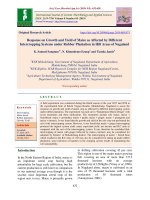
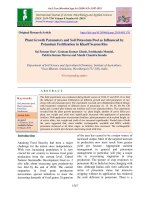
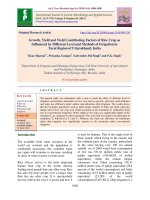

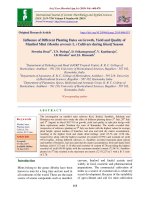
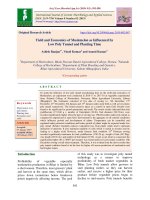

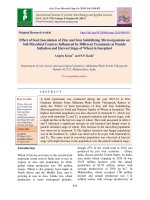
![Growth and yield of Ashwagandha [Withania somnifera (L.)] as influenced by different intercropping system in Kymore plateau of Madhya Pradesh](https://media.store123doc.com/images/document/2020_01/09/medium_vsb1578562778.jpg)
